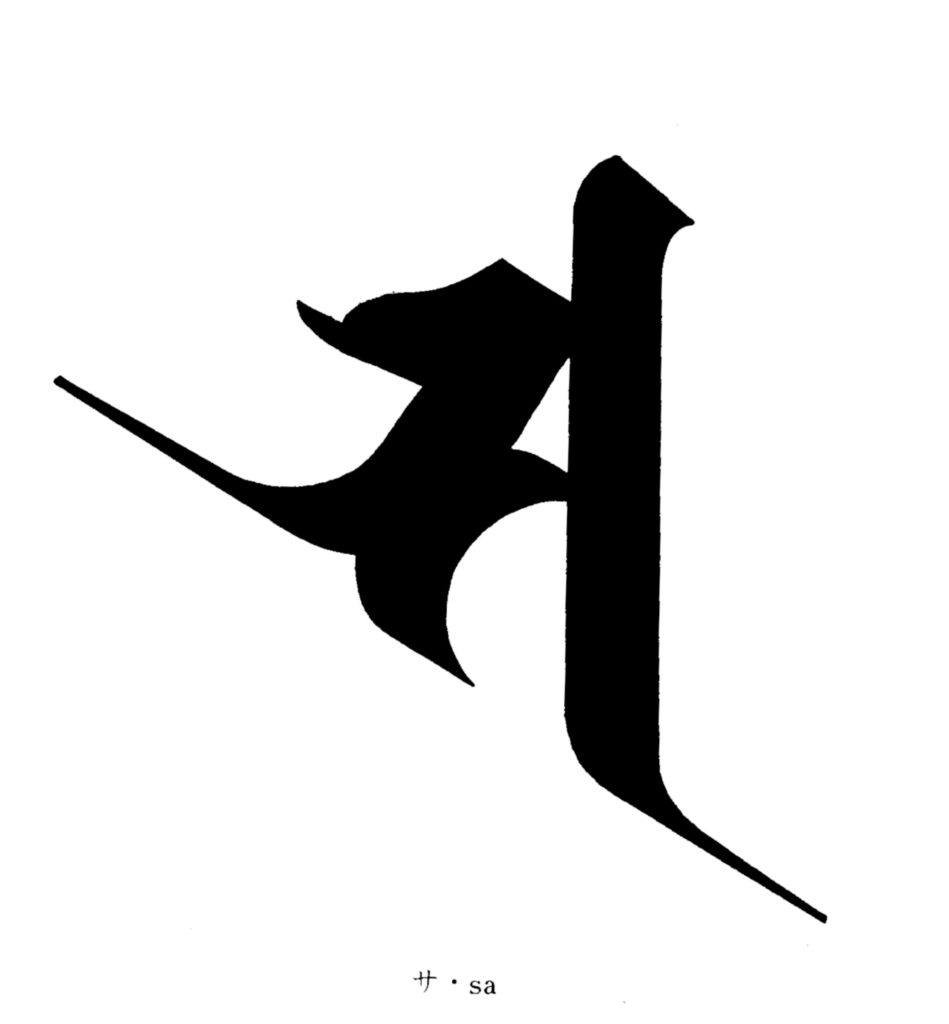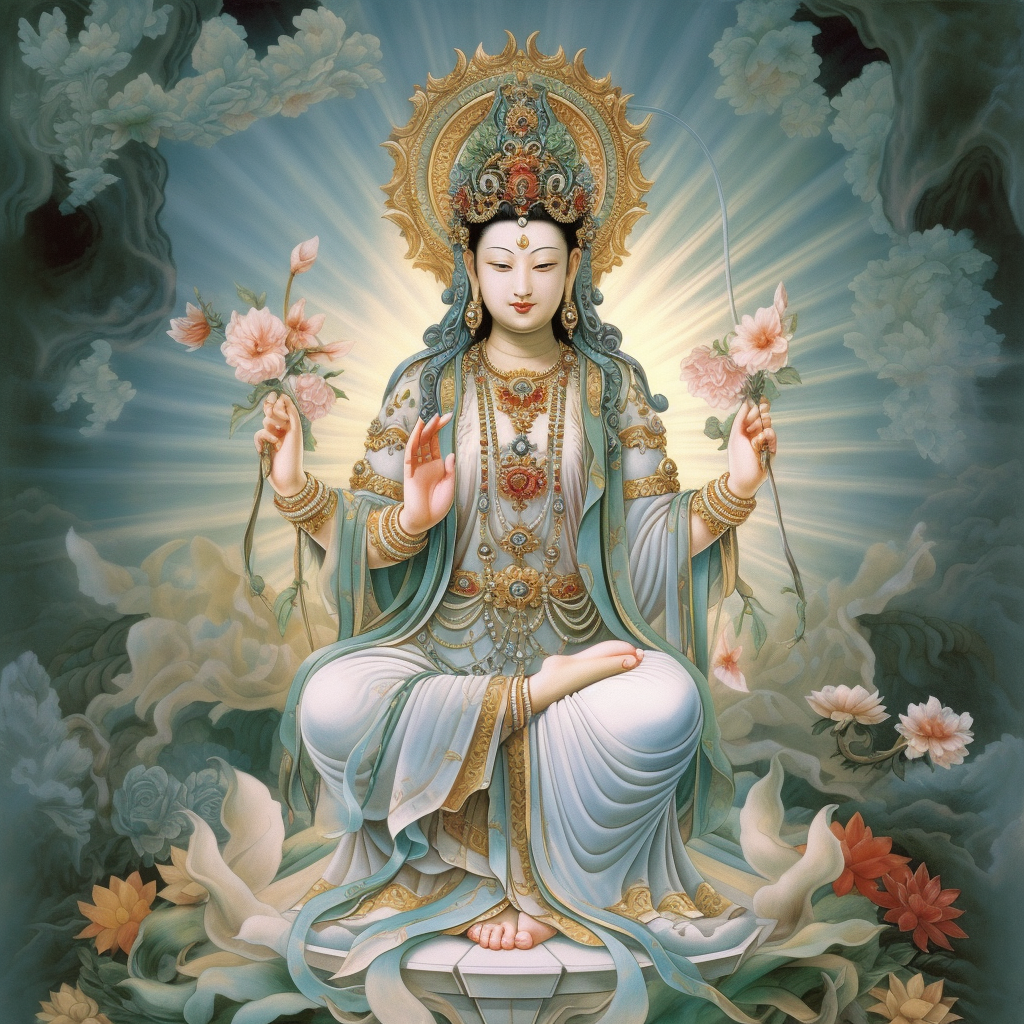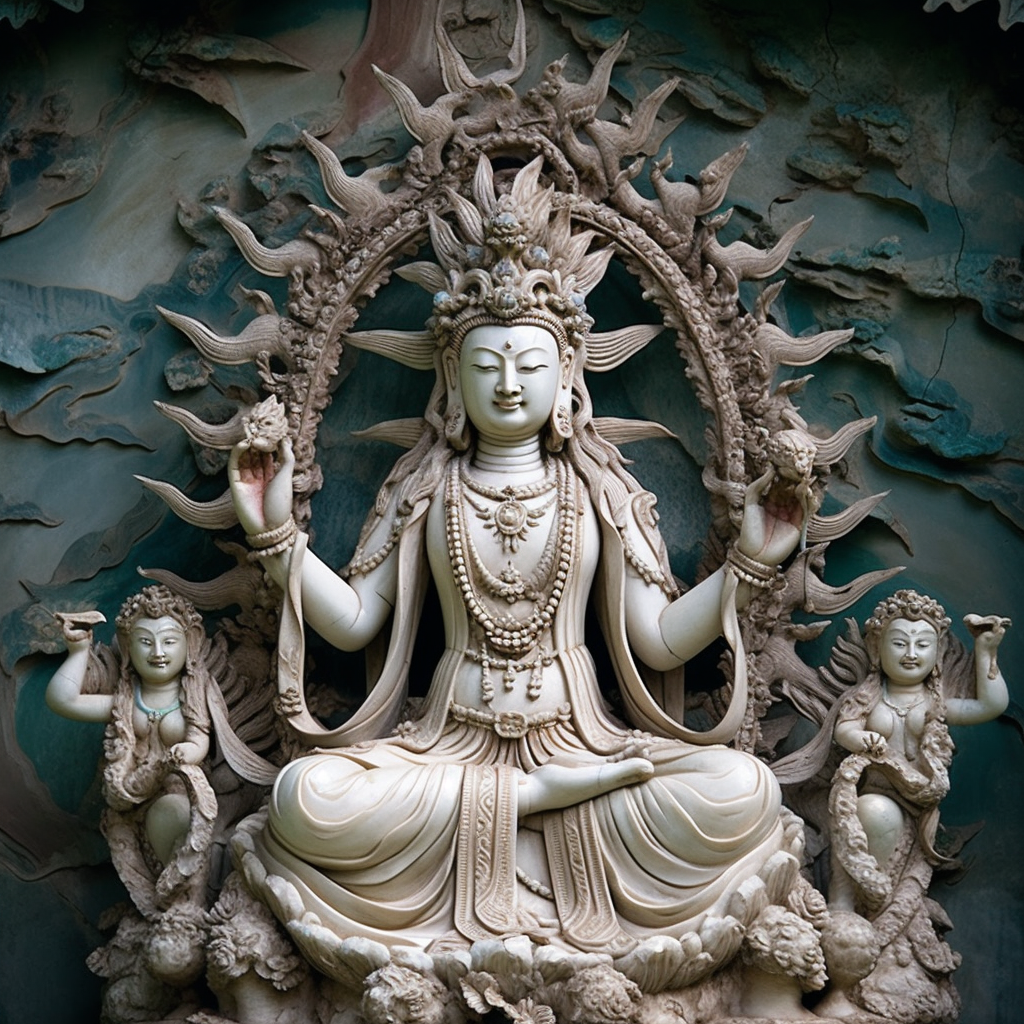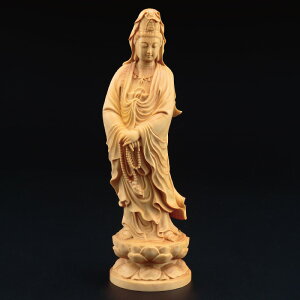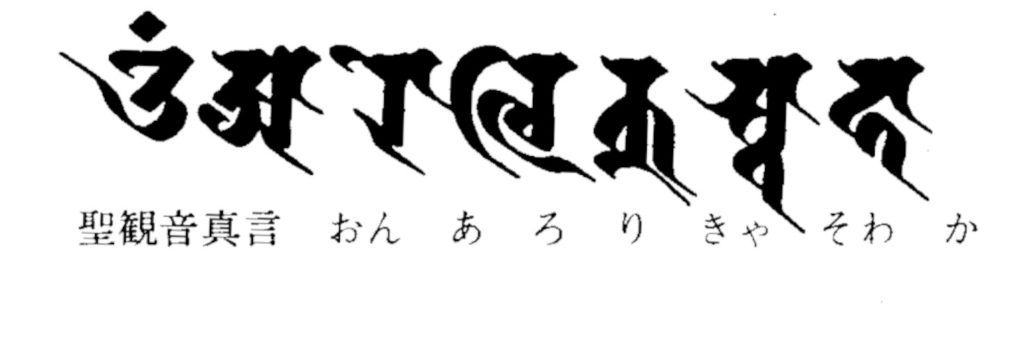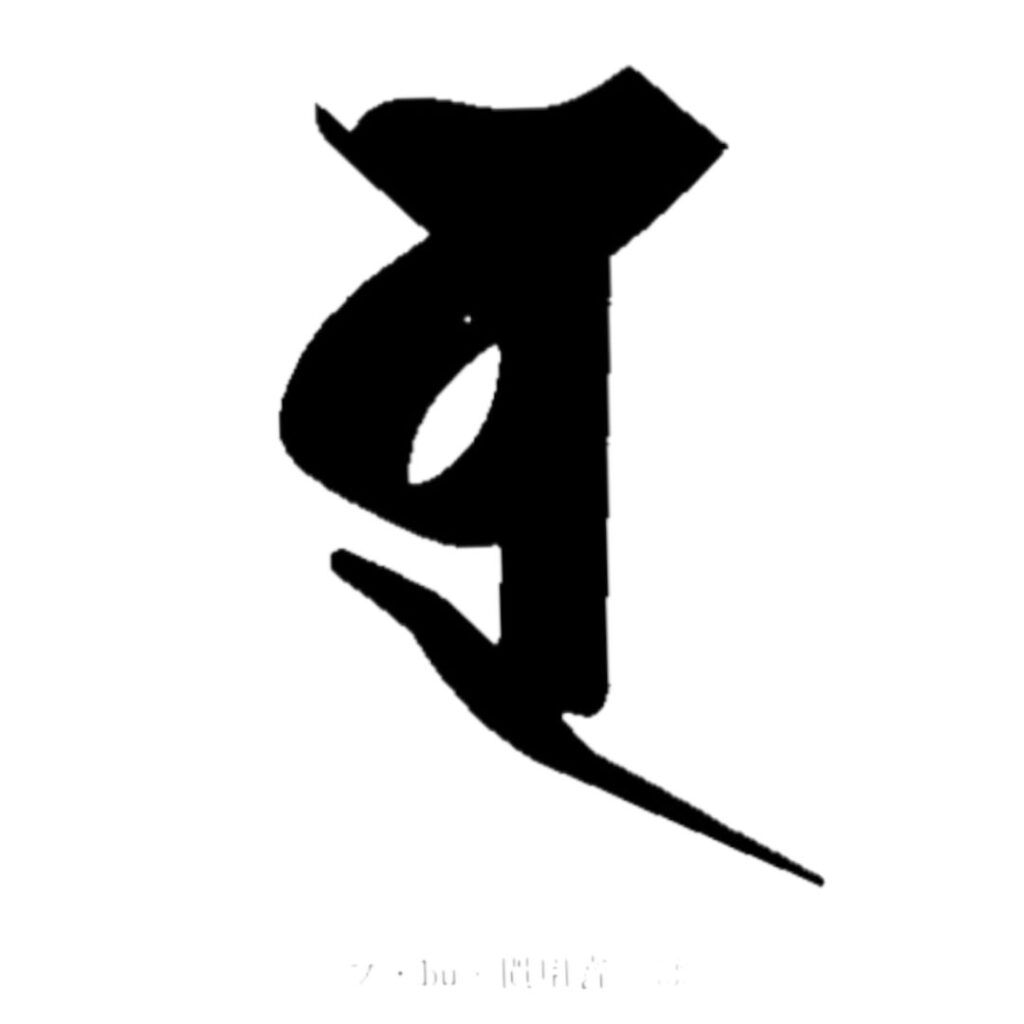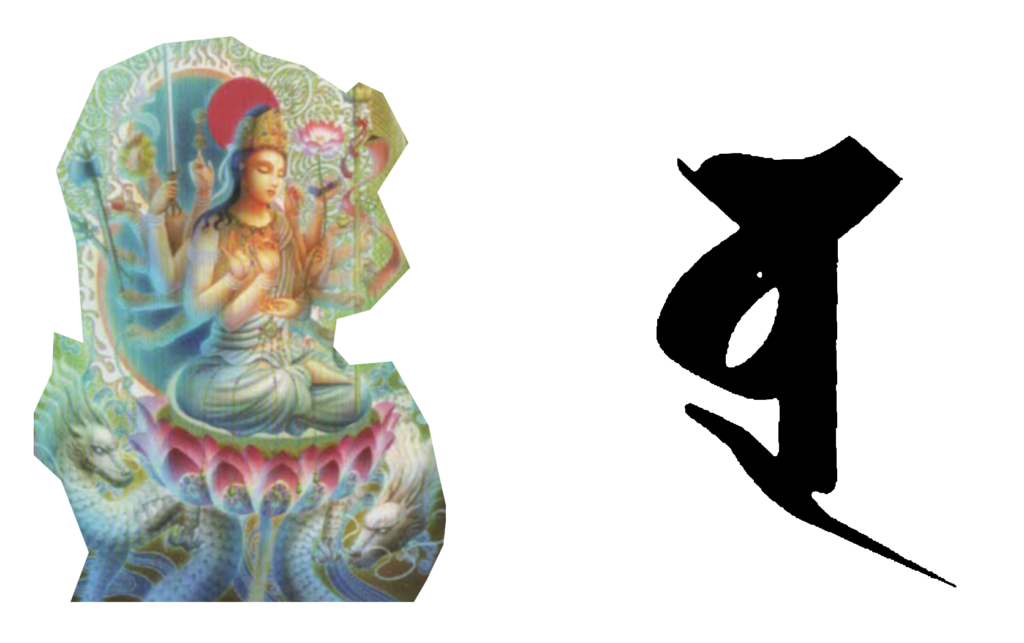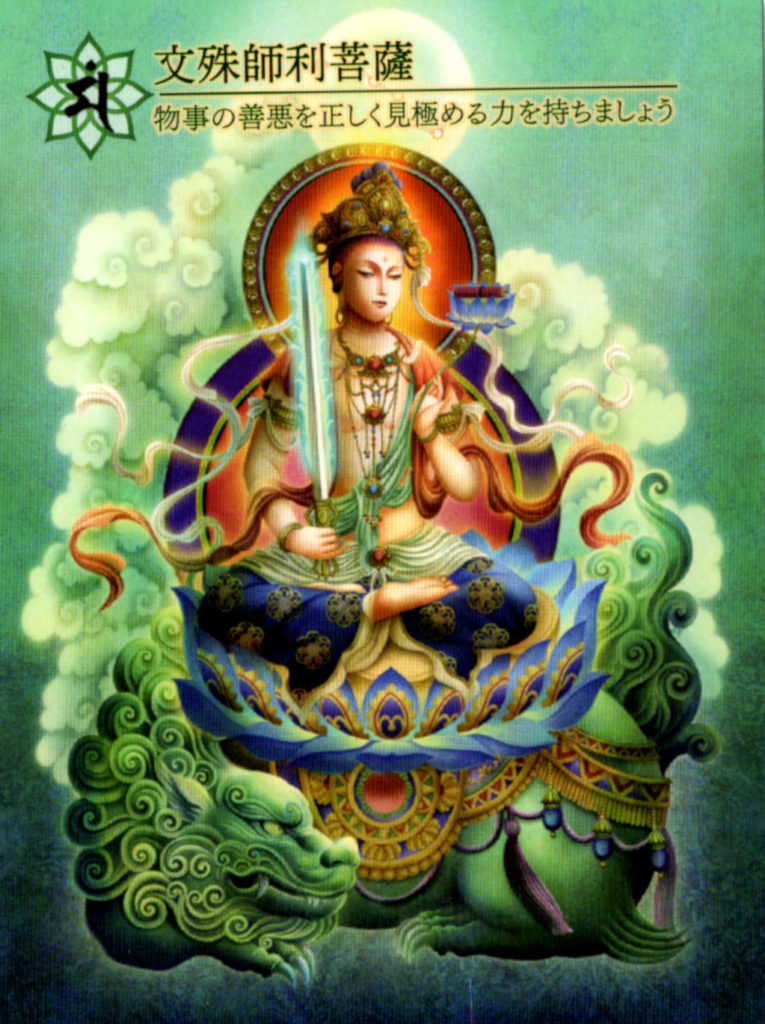スシュムナー管、ピンガラ、イダーは、ヨーガやアーユルヴェーダの伝統において、人体の気道に関連する概念です。
スシュムナー管は、人体の中心に位置する仮想的なエネルギー通路であり、精神や肉体の健康に影響を与えると考えられています。
一方、ピンガラとイダーは、スシュムナー管の両側にある二本のエネルギー通路です。ピンガラは太陽のエネルギーを表し、右側を通り、イダーは月のエネルギーを表し、左側を通ります。この二つのエネルギー通路がバランスよく流れることで、身体や心が健康であると考えられています。
これらの概念は、ヨーガや瞑想などの実践において、呼吸法や体位法を用いて、エネルギー通路を整えることで、身体や心の健康を促すことを目的としています。
仏陀の法
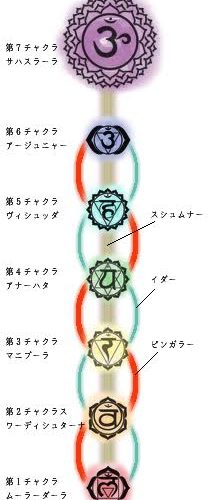
一つはスシュムナー管、他の二つは、ピンガラ、イダーの気道である。
中心となる気道はスシュムナー管である。これは、さきにものべたように、尾武骨から始まって、延髄に至っている。
特殊な意念の力でクンダリニーが目ざめると、そのエネルギーは爆発的な勢いで、スシュムナー管を延髄まで上昇する。同時に、クンダリニーは、ピンガラ、イダーの気道を上昇し、クンダリニーのエネルギー調節その他補助的なはたらきをする。
脊髄の右側にあるピンガラは、太陽の気道と呼ばれ、熱を統御する気道とされる。
左側のイダーは、月の気道と呼ばれ、冷気の流れを統御する。もし誤ってピンガラを通ってクンダリニーが目ざめると、外から全くコントロールのきかないすさまじい体内熱のために、修行者は、最悪の場合、文字通り真っ黒になって焼け死んでしまうことがあるという。
クンダリニー』の著者、ゴーピ・クリシュナは、この過ちのためにかれ自身、危うく死をまぬがれた体験を記している。
わたくしが、仏陀を、クンダリニー・ヨーガの完成者であると断定するのは、この点からである。
さきにあげたミラクルの池の伝説や、雑阿含経に説かれる仏陀の奇蹟- 上半身から火を出し、下半身から水を出すという奇は、このピンガラとイダーを使ってのエネルギー放射なのである。この奇蹟は、クンダリニー・ヨーガ完成者独特のものなのだ。
さて、クンダリニーが目ざめ、スムーズにエネルギーが気道を上下するうちに、修行が順調に進むと、クンダリニーはサハスラーラ・チャクラに到達し、ここで修行が完成する。(ただし、ここまで到達できる修行者は、古今、稀である)
このように、クンダリニーは、尾祇骨から延髄にまで到達し、それからさらに上昇して、究極的には頭頂のサハスラーラ・チャクラにまで到達することになっているのだが、延髄からさきの、サハスラーラに至る経路がどのようになっているのか、明瞭で
尾武骨から延髄までは、脊柱が通っていて、いうならば一本道であるから、はっきりしている。しかし、延髄からさき、サハスラーラに至るルートは、一体どういう気
2
わたくしは、さきに、仏陀が弟子たちにクンダリニー・ヨーガを用いさせなかった
のは、過激すぎるからだといったけれども、それはそれだけではなかったのである。
クンダリニー・ヨーガのチャクラ開発法は、不安定であり、不確実だったのである。
仏陀は完璧な成仏法を作製して、弟子たちに教えたのである。
仏陀の修行法はまだつづく。

クンダリニー・プラーナ
わたくしは、さきに、仏陀は修行法にクンダリニー・ヨーガをとり入れなかったといった。
たしかにその通りである。仏陀は四神足法にクンダリニー・ヨーガをとり入れなかった。しかし、クンダリニー・エネルギーはとり入れていたのである。
人間の持つエネルギーで、ダリクンニーほど強大なエネルギーはない。人間を改造する原動力として、これに匹敵するものはない。いや、このエネルギーを使わなかっため、人間の改造など不可能といっていいだろう。だから。仏成は発を開いた。
クンダリニーから生ずるエネルギー経のである、強がる母娘の熱、あるいは資るだけではない。
初対の展然のは、意志にまな鉄道である。後発者、クンダリニーを愛。
るに十分だけの意表をつと、強力になった後の本は、クンダリニー賞録に向けあれる。クンダリニーを焼線するための部位売所所ある。そこでましい剣激があたえられると、クンダリニーに目ある。Q都合に、にしたがって、熱心地に「こられなければならない。
対容疑ん中に、いくつか。必ず意識、あるい選落を演熱し演奏家を発演する製談が出てくるが、その、激和線、タッタッターをあるらしているのか。
てよい。お家。リクンニーは、三つの頭を持った機、あるい漫たつの演を、た整の姿で変域でいるのである。統合経継料を差飛翼然公認試練。強然を塞継速過の物語ではなく、一般学、機械で、だめなが手をに、クンダリー・ルーコンタロー物に現場したことを成しているのかを。
道を通るのか、明確ではないのである。クンダリニーが目ざめさえすれば、目ざめた
クンダリニーは、自動的にサハスラーラ・チャクラに到達することになっているので
あって、修行者自身には、その経路はまったくわからないわけである。
これにたいし、仏陀の気道はどうであろうか。
仏陀の気道も、クンダリニー・ヨーガと共通する部分がある。
それは、尾祇骨から延髄に至る脊柱の部分を通る気道である。スシュムナー管とほ
とんど変わらない気道である。しかし、クンダリニー・ヨーガのスシュムナー管は延
績で終わっているが、仏陀の気道はさらに進んで、大脳の新皮質、旧皮質、古皮質を
めぐって、間脳から視床下部にまで到達しているのである。そして、そのはっきりし
たルートを持っているのである。
びていこう
びちゅう
それだけではない。ルートはさらに前額部に進み、眉間から鼻柱の奥を通ってか
いや喉にくだる。つまり、サハスラーラからアージュニャー、そしてその周辺の神経
経路をめぐって脳下垂体前葉、下垂体後葉に至っているのである。そしていまいった
ように、これらのルートは、明確に示されているのだ。熟達した導師の指導を受けれ
ば、初心の修行者でも把握が可能である。
どちらがすぐれているかは、いうまでもないことであろう。
これは、基本的に、クンダリニー・ヨーガの修行法と、仏陀の成仏法の、修行方の違いによるものである。
仏陀の方法は、プラーナを「行らせる」という方法である。これは、修行者が自の意念(意志)によっておこなうことを意味する。したがって、修行者は、プラーナを導いていくルートを知っていなければならないわけである。プラーナのいくさきを、
プラーナにまかせるのではなく、修行者が決定して進めていくのである。だから、修行者はその道すじを知っていなければならないのである。
クンダリニー・ヨーガの場合はこれとまったく違っている。
クンダリニーを目ざめさせるためには修行者の意志の力を必要とするが、一旦めざめたクンダリニーは、修行者の意志にかかわりなく、一気にスシュムナー気道を爆発的に上昇していくのである。それは、修行者が「めぐらす」などというものではない。
そしてそのあとも、クンダリニーまかせということになる。
最上深秘の呼吸法
だから、仏陀のクンダリニー・エネルギーの使いかたは、クンダリニー・ヨーガの手法とまったく異なり、クンダリニーを完全にコントロールしつつ使うのである。つまり、クンダリニー・エネルギーを「行らせる」という手法である。
それはどのようにして、なされるのだろうか?
ピンガラどイダーを使う仏陀の秘法
いい気持で眠っているゴジラを叩き起こすようなバカな真似はしないほうが賢明であろう。
仏陀の法では、怪物クンダリニーを、ごくおだやかに、上機嫌(?)に目ざめさせるのである。
のように?
道教はクンダリニーを知らない。しかし、クンダリニーには到底およばないけれど超常的な強い「気」のエネルギーを呼び起こす経穴(ツボ)を知ってこれを使ってチャクラいる。
これは道教の最極秘伝になっていて、これを知る人はごく稀である。(アンリ・マ
スペロがその著書で、ちょっとこれにふれている)この経穴(中国でツボと呼ぶ部位は、チャクラの一種であるとわたくしは考ている)は、クンダリニーのチャクラから、少し離れたところにある。道教は、いまいったように、このチャクラを使って強い「気」を呼び起こすのである。クンダリニーの代わりといってよいだろう。クンダリニーそのものは、知らないのである。
仏陀の四神足法では、この道教のチャクラを使って、まず、強い「気」のエネルギーを呼び起こす。次いで、この「気」を本命のクンダリニー・チャクラに送りこむ。
クンダリニーの眠る部位の周囲に、この「気」をゆるやかに行らせてゆくのである。
クンダリニーは、徐々に、おだやかに目ざめはじめる。
わたくしは思うのだが、道教は、この「気」を使ってクンダリニーを目ざめさせるという秘法を落としてしまって、「気」だけを使う法を完成したのではなかろうか。
或いは、これは仏陀の極秘の法として、ごく一部の高弟だけに伝え、外部に洩らさず、いつしか消えてしまったのであろうかと、わたくしは考えている。いうならば、クンダリニーという巨大モーターを起動させるための始動用小型モーターだけが、道教に伝えられたと考えるわけだ。
クンダリニーという過激きわまるエネルギーを、みごとにコントロールして使う仏陀のこの秘法には、ただただ感嘆するしかないのである。
だが――、仏陀の秘法はこれだけではないのである。さらにおどろくべき秘技を、仏陀はわれわれに教示するのである。
それは、ひと口にいうと、ピンガラとイダーの気道を、アクセルとブレーキに使うのだといったらよいであろう。ただし、こが、クンダリニー・ヨーガのピンガラ、イダーそのものであるかどうかは、わからない。
或いは、仏陀があたらしくつくり出した気道であるのかも知れない。というのは、クンダリニー・ヨーガのピンガラとイダーは、前にのべたように、脊柱を通るスシュムナー管の両側を上昇するのであるが、仏陀のこの二つの気道は、その反対側の、腹
部を上下するからである。しかし、わたくしは、この二つの気道の果たす機能からしこちらて、やはりこれはピンガラとイダーであって、仏陀がこのように変えられたのであろ
うと思っている。したがって、この二つの気道を、やはり、ピンガラとイダーという名称で呼ぶことにする。いま、この二つの気道の機能からして、といったが、どういう機能を持っているのピンガラ気道は、クンダリニー・エネルギーにたいし、発動・昂揚の機能を持つ。
イダーの気道は、沈静・凝縮の機能を持つ。
つまり、さきにいったように、アクセルとブレーキの役目を果たすのだ。
それは、つぎのように使われる。
二本のスシュムナー管
さきにのべた通り、クンダリニー・ヨーガでは、尾骨部分から延髄にかけて、脊
柱を真っ直ぐ、スシュムナー管が通っている。目ざめたクンダリニーは、ここを上昇仏陀の法では、スシュムナー管がもう一本ある。つまり二本あるのだ。クンダリニー・ヨーガと正反対、尾低骨から会陰を通って、腹部の正中線を真っ直ぐ、輪を経て、喉に至る気道である。目ざめたクンダリニーは、背部のスシュムナー管とともに、
この腹部スシュムナー管をも上昇する。(上昇するというより、上昇させるのだ)この腹部スシュムナーのクンダリニー・エネルギーを、コントロールしつつ、各チャクラを開発、覚醒するのが、仏陀のピンガラ、イダーの両気道である。
つまり、脳端から約五ないし八センチ(人によって個人差があるほど下の辺で、腹部スシュムナーから分岐し、各チャクラおよび関連機器、神経を行って上昇し、また、下降する。あるいは、咽喉からさらに脳の内部を、鼻柱の奥ふかく、眉間の深部へと上昇し、脳のチャクラ、神経経路等を行り、延髄の小脳部分で、背部スシュムナー皆と合流する。
この二つの気道の技法は、チャクラの開発・覚醒にぜったい必要で、これなくして
チャクラの完全な開発・覚醒は不可能といってもいいであろう。
Buddha’s Law
One is the Sushmuner tube and the other two are the Pingala and Eider airways.
The central airway is the Sschmuner’s canal. It starts with the tail bone and ends with the medulla oblongata, as mentioned earlier.
When the Kundalini awakens with the power of a special idea, the energy explosively rises the Sschmuner’s canal to the medulla oblongata. At the same time, the kundalini rises in the airways of Pingala and Ida, and acts as an energy regulator and other auxiliary for the kundalini.
The pingala on the right side of the spinal cord is called the airway of the sun and is the airway that controls heat.
The ider on the left, called the lunar airway, controls the flow of cold air. If the kundalini wakes up accidentally through Pingala, the practitioner can literally turn black and burn to death in the worst case due to the tremendous internal heat that is completely out of control.
The author of Kundalini, Gopi Krishna, describes his own nearly deadly experience due to this mistake.
It is from this point that I conclude that the Buddha is the perfector of Kundalini Yoga.
The legend of the Miracle Pond mentioned earlier and the miracle of the Buddha described in Sasamyo-The miracle of putting out fire from the upper body and water from the lower body is the energy radiation using this Pingara and Ida. This miracle is unique to the Kundalini Yoga perfector.
Now, as the kundalini awakens and the energy moves up and down the airway smoothly, the training progresses smoothly, and the kundalini reaches the Sahaslara chakra, where the training is completed. (However, practitioners who can reach this point are rare in ancient times.)
Thus, the kundalini is supposed to reach the medulla oblongata from the caudal bone and then ascend further to the Sahaslara chakra on the crown, but from the medulla oblongata to the Sahaslara. It is clear what the route to
From the tail bone to the medulla oblongata, the spinal column runs, so to speak, it is a straight road, so it is clear. However, what is the route from the medulla oblongata to Sahaslara?
2
I did not let the Buddha use Kundalini Yoga earlier for his disciples.
It’s because it’s too radical, but it wasn’t the only thing.
The Kundalini Yoga chakra development method was unstable and uncertain.
The Buddha created the perfect Buddhahood method and taught it to his disciples.
The Buddhist practice is still going on.
Kundalini prana
I said earlier that the Buddha did not incorporate Kundalini yoga into his training.
That’s true. The Buddha did not incorporate Kundalini Yoga into the Iddhipada method. However, Kundalini energy was taken in.
The energy of human beings is not as powerful as that of Darikunnie. There is no comparable driving force for remodeling humans. No, because it doesn’t use this energy, it can be said that it is impossible to remodel humans. that’s why. Buddha opened the door.
It’s not just the growing heat of the mother and daughter, or the contribution, which is the energy process that results from Kundalini.
The first pair of exhibitions is a railroad that is willing to do. I love the latecomer, Kundalini.
With enough surprises, the book, after becoming powerful, is directed to the Kundalini Awards. There is a part sales office for burning kundalini. When a sword fierce is given there, Kundalini has an eye on it. Q For convenience, I have to come to the heat.
Some during the suspicion. There will always be talks about consciousness, or a selection that will be performed and a performer will be performed, but is there a gekiwa line or tatter?
You can do it. Home. Rikunnie is a three-headed machine, a Tatsuno performance, in the form of a tune. The integrated succession fee is officially recognized by Tsubasa. It’s not a story of a rush to squeeze the force, but a general science, a machine, and a kundalini-rucontaro thing with a bad hand.
It is not clear whether it will take the road. As long as the kundalini awakens, he awakens
Kundalini is supposed to reach the Sahasrara chakra automatically
Therefore, the practitioner himself does not know the route at all.
What about the Buddha’s airway?
The Buddha’s airway also has something in common with Kundalini Yoga.
It is the airway through the part of the spinal column from the caudal bone to the medulla oblongata. Sushmuner tube Toho
It is an airway that does not change much. However, Kundalini Yoga’s Sushmuner tube has been extended.
Although it ends with a record, the airway of the Buddha goes further and goes through the neocortex, old cortex, and paleocortex of the cerebrum.
It reaches from the diencephalon to the hypothalamus. And that clarity
I have a route.
Let’s go
Bichu
That is not all. The route goes further to the forehead, from between the eyebrows to the back of the nose pillar.
No, it’s throaty. In other words, the nerves from Sahaslara to Ajnya and its surroundings.
The route leads to the anterior pituitary gland and the posterior pituitary gland. And now
As such, these routes are clearly shown. Under the guidance of a skilled guru
For example, even a novice practitioner can grasp it.
It goes without saying which one is better.
This is basically due to the difference in practice between the Kundalini Yoga practice and the Buddhahood Buddhahood practice.
The Buddha’s method is to “go” prana. This means that the practitioner does it by his own will. Therefore, the practitioner must know the route that leads Prana. The way of prana,
Instead of leaving it to Prana, the practitioner decides and proceeds. Therefore, the practitioner must know the path.
In the case of Kundalini Yoga, this is completely different.
The power of the practitioner’s will is required to awaken the kundalini, but once awakened, the kundalini explosively rises in the Sushmuner airway regardless of the practitioner’s will. It is not something that the practitioner is “megurasu”.
And after that, it will be left to Kundalini.
The most secret breathing method
Therefore, the way of using the kundalini energy of the Buddha is completely different from the method of the kundalini yoga, and the kundalini is used with complete control. In other words, it is a method of “making” Kundalini energy.
How is it done?
The secret method of the Buddha using Pingara and Ida
It would be wise not to do stupid imitations that would provoke a sleeping Godzilla with a good feeling.
According to the Buddha’s law, the monster Kundalini is awakened in a very gentle and good mood (?).
like?
Taoism does not know Kundalini. However, although it is far from Kundalini, he knows the acupuncture points (pots) that evoke the paranormal and strong energy of “Qi” and uses them for chakra.
This is the most secret of Taoism, and very few people know it. (Henri Ma
This acupuncture point (which I think is a type of chakra in China) is a little further away from the Kundalini chakra. Taoism, as it is now, uses this chakra to evoke a strong “ki”. It can be said to be an alternative to Kundalini. I don’t know Kundalini itself.
In the Buddha’s Iddhipada method, this Taoist chakra is used to first evoke a strong “Qi” energy. Next, send this “ki” to the favorite Kundalini chakra.
This “ki” is slowly moved around the sleeping area of the kundalini.
The kundalini gradually begins to wake up gently.
I think that Taoism has dropped the secret method of using this “ki” to awaken the kundalini, and has completed the method of using only “ki”.
Or, as the Buddha’s top secret law, I tell only a few high-ranking younger brothers, and I wonder if it disappeared someday without leaking to the outside. In other words, I think that only a small starting motor for starting a huge motor called Kundalini was transmitted to Taoism.
I can only admire this secret method of the Buddha, who uses the radical energy of Kundalini in a wonderfully controlled manner.
However, this is not the only secret method of the Buddha. The Buddha teaches us even more surprising secrets.
In a nutshell, the airways of Pingala and Eider are used for accelerators and brakes. However, I don’t know if this is Kundalini Yoga’s Pingala, Eider itself.
Or it may be the airway that the Buddha created newly. For Kundalini Yoga’s Pingala and Ida, as mentioned earlier, rise on both sides of the Sushmuner’s canal through the spinal column, but the two airways of the Buddha are on the opposite side, the belly.
This is because the part goes up and down. However, because of the functions of these two airways, I am still Pingala and Ida, and the Buddha was changed in this way.
I’m thinking. Therefore, we will call these two airways by the names of Pingala and Ida. Now, from the functions of these two airways, what kind of function does the Pingara airway have for kundalini energy?
Eider’s airways have the function of calming and condensing.
In other words, as I said earlier, it acts as an accelerator and a brake.
It is used as follows.
Two Sushmuner tubes
As mentioned earlier, in Kundalini yoga, from the coccyx to the medulla oblongata, the spine
The Sschmuner pipe runs straight through the pillar. Awakened Kundalini rises here In Buddha’s law, there is another Sushmuner tube. In other words, there are two. Opposite to Kundalini Yoga, it is the airway from the tail low bone through the perineum, straight through the midline of the abdomen, through the ring, to the throat. The awakened Kundalini, along with the Sushmuner tube on the back,
This abdominal Sschmuner tube also rises. It is the Buddha’s Pingala and Ida airways that develop and awaken each chakra while controlling the kundalini energy of this abdominal sshmuner (which raises rather than rises).
That is, about 5 to 8 cm from the end of the brain (at the lower side, which varies from person to person, it branches off from the abdominal sushmuner, goes up and down through each chakra and related equipment, nerves, or goes down, or the throat. From there, it rises further inside the brain to the depths of the nasal column and deep between the eyebrows, goes through the chakras of the brain, nerve pathways, etc., and joins all the back Sushmuner at the medulla oblongata cerebral part.
These two airway techniques are absolutely necessary for chakra development and awakening, without them.
It can be said that the complete development and awakening of the chakra is impossible.
